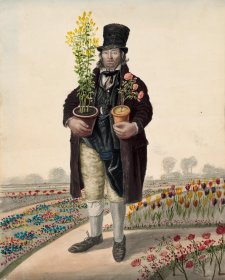It has been estimated that, at the turn of the 20th century, there were 50,000 horses in harness in central London: a workhorse workforce producing some 1,000 tonnes of dung every day. Although the equine population and its by-products were considerably reduced in the 1820s, the streets of Regency London were nevertheless dirty and treacherous, muddy and smelly, and many of the very poor earned a meagre living as ‘crossingsweepers’, making a clear path across the road and importuning passing pedestrians. Like the street-singer and the match-seller, the crossingsweeper was often described as being just one step above outright beggary.
Thanks to the character of Jo in Charles Dickens’s Bleak House (1852), and to the popular and widely reproduced painting by William Powell Frith (1858), the sweeper is most commonly pictured as a ragged boy. Youngsters are shown in the role even before mid-century, in prints by Robert Sayer (1791), William Marshall Craig (1804) and Thomas Rowlandson (1820). Catalogues of John Thomas Smith, Charles Manby Smith and Henry Mayhew reveal the demographic to be, however, considerably broader: of the five sweepers illustrated in John Thomas Smith’s Vagabondiana, for example, only one is described as a ‘lad’.
Dempsey’s unnamed female, pictured in front of her cleaned ‘broom walk’, is one of his most abject figures. With her bonnet and hat, shawl and apron she seems careful to retain some residual neatness and respectability, but the drawn, vacant expression on her face and the hapless passivity of her open palm suggest long-term penury.
On the opposite side of the street, a faintly arcaded wall bears two signs: ‘Newgate Street’ and ‘Fleet Street’. This would at first suggest that the crossing sweeper is standing at the point where the roadway changes its name but, in fact, Newgate Street and Fleet Street run parallel. It is possible that the artist has his geography confused. But we could consider the signs as directional, which would place the signs in one of the streets that link Newgate and Fleet streets: Old Bailey or Fleet Lane. This in turn puts our beggar woman somewhere between Newgate (the criminal gaol) and the Fleet (the debtor’s prison). In this location she can stand for many of Dempsey’s people, surviving narrowly on the street, somewhere between bankruptcy and crime.
Collection: Tasmanian Museum and Art Gallery, presented by C. Docker, 1956



Dempsey’s people: a folio of British street portraits 1824–1844 is the first exhibition to showcase the compelling watercolour images of English street people made by the itinerant English painter John Dempsey throughout the first half of the nineteenth century.



Visit us, learn with us, support us or work with us! Here’s a range of information about planning your visit, our history and more!



We depend on your support to keep creating our programs, exhibitions, publications and building the amazing portrait collection!